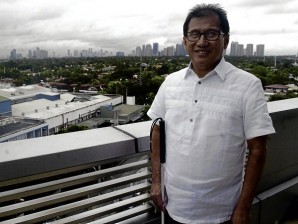Blind architect keeps building ‘inclusive society’ for PWDs

MAN WITH A VISION Blind for 30 years, Jaime Silva didn’t let his condition slow him down. It even led him to a noble cause. ARNOLD ALMACEN
A lot still has to be done in the country for people with disabilities (PWDs), but architect Jaime Silva is thankful for small victories.
Over the past six years, for example, he has been giving lectures to shopping mall “front-liners”— like security guards and housekeeping personnel—on how they can help build a more inclusive society for PWDs.
He remains on target in his advocacy, despite being blind himself. Silva lost his vision 30 years ago.
One such victory, according to Silva, took place when he spoke with an SM mall manager earlier this year.
“While we were talking, a member of the staff brought in coffee. I then felt someone guide my hand to my cup, telling me where it was on the table,” Silva recalled.
Article continues after this advertisementAt first, he thought it was the manager who took his hand. But when he learned it was the housekeeping staff member who did it, he was pleased. In such a situation, he said, mere verbal instructions would not suffice for a blind person.
Article continues after this advertisement“I felt that what we are doing at the malls, teaching their front-liners how to assist PWDs, was finally bearing fruit,” Silva said.
Silva was managing his own architecture firm in the late 1970s when he had frequent headaches and problems with his vision. He was later diagnosed with congenital glaucoma.
In January 1982, Silva flew to the United States for a series of surgeries that took eight years. He bravely faced this harrowing period in his life, till it took away the most basic tool he needed as an architect.
As his vision failed, he busied himself with various businesses, from merchandising to farming, from 1989 to 1993.
His heart never left
But his heart never left architecture. Determined to reclaim his sidetracked career, he enrolled in a comprehensive computer training program for the visually impaired.
Experience and determination led him to his present job handling infrastructure projects as administrative and leasing manager of Cyan Management Corp. He now manages several office and commercial buildings and is a consultant for a call center in Makati City and a golf course in Laguna province.
“Having a day job enables me to both provide for my family and pursue my advocacy to help other PWDs,” he said.
Twice a year, Silva conducts lectures in Metro Manila malls, mostly in the SM Supermall chain.
One lecture targeted security guards and other employees as they braced for the summer crowds, while another prepared them for Yuletide shoppers.
In these lectures, Silva raises four basic points in dealing with the blind: “First, put in mind that the blind can still do many things such as walk, listen, talk, touch and smell. A blind person is only sightless, but is normal in every way.”
Second, the visually impaired do not want to be “excluded” from society’s activities. “They deserve to get an education, earn a living, get married and start families of their own, too.”
Third, while blind people would certainly welcome any form of assistance, the helper might as well do it “the right way.”
“The moment I step into a building, I only have a split second to decide where I want to go next,” he said, by way of example. But some security guards tend to “upset” him before he can make that decision by pulling him to a corner for “blocking” the entrance.
“I get disoriented when this happens and I lose my sense of direction,” Silva said. “The best way to help is to ask me where I want to go.”
Fourth, Silva said, sighted persons should not feel uncomfortable whenever they interact with the blind. “People sometimes assume that because we’re blind we’re also deaf, so they raise their voices or speak very slowly.”
Be verbal, not visual
When giving directions, “verbal rather than visual instructions” should be used. “Tell him the toilet is 10 steps to his right” rather than say “doon (over there),” he added. “The worst thing would be to point using your lips.”
It is also not advisable to make the blind hold on to your shoulder while walking. This prevents the sighted person from checking if the blind person is having a hard time keeping up, especially if they are taking the stairs or on a ramp.
“The best way is to offer your elbow, after asking which side the blind person is more comfortable with,” he said. This enables the blind “to listen to your body movement.”
To help blind people settle down in a chair, make them touch the backrest and the seat. In a restaurant, read the menu to them, let them know where the glasses are, making sure these are not full to the brim, and how the food is arranged on the table.
‘Society is a box’
“Also, do not forget to introduce yourself first when starting a conversation with a blind person,” he added. And don’t forget to tap him on the shoulder if you need to leave.
During a PWD conference abroad, he once heard of this illustration explaining the plight of the PWD: Society is a box with a hole through which various sectors— business, labor, students, etc.—try to get in.
“The PWD sector is represented by a star,” he said. ‘’While the other sectors can easily get into the hole, there is a dilemma as to how that star can get in.”
There are two ways to include the star in society, Silva explained: One is to cut off the star’s “arms.” The other is to make the hole bigger.
“And making that hole bigger means providing a more inclusive society for PWDs,” he said.